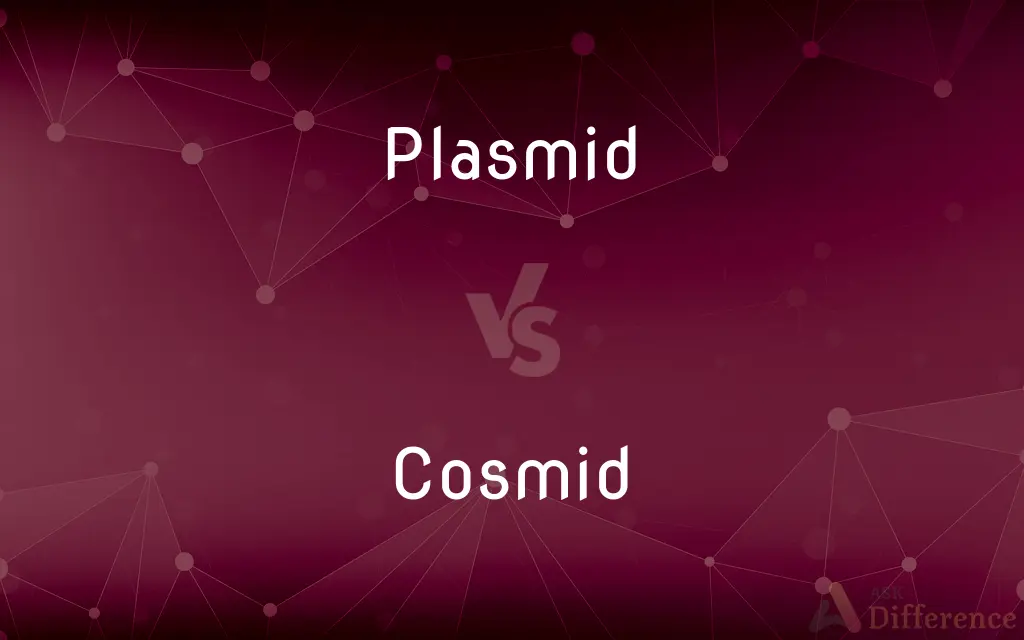Plasmid vs. Cosmid — What's the Difference?
By Tayyaba Rehman & Fiza Rafique — Updated on March 20, 2024
Plasmids are small, circular DNA molecules found in bacteria, while cosmids are engineered vectors that combine plasmid and bacteriophage elements to carry larger DNA fragments.

Difference Between Plasmid and Cosmid
Table of Contents
ADVERTISEMENT
Key Differences
Plasmids are naturally occurring, circular DNA molecules independent of the bacterial chromosome, often carrying genes beneficial for bacterial survival. In contrast, cosmids are laboratory-created vectors that incorporate features of plasmids and bacteriophages, designed to clone larger DNA sequences than plasmids typically can.
While plasmids can replicate autonomously within bacterial cells and can carry a few genes, cosmids are engineered to include a plasmid origin of replication and bacteriophage cos sequences, allowing them to package and transfer larger DNA segments, up to 45 kilobases.
Plasmids are used in genetic engineering for cloning, gene expression, and transferring genes between organisms. Cosmids, with their capacity to carry larger DNA fragments, are especially useful in genomic library construction and in studying large gene clusters or whole genomic regions.
The replication and maintenance of plasmids depend on their own origin of replication, making them relatively stable within host cells. Cosmids, leveraging the packaging and infection efficiencies of bacteriophages, can introduce large DNA fragments into host cells more efficiently than standard plasmids.
Plasmids often carry antibiotic resistance genes, which researchers use as markers for selecting successfully transformed cells. Cosmids may also contain selectable markers, but their key feature is the cos site, allowing DNA to be packaged into phage particles for efficient transfer.
ADVERTISEMENT
Comparison Chart
Nature
Naturally occurring circular DNA
Engineered vector combining plasmid and phage elements
Size Capacity
Typically carries small DNA fragments
Can clone larger DNA fragments (up to 45 kb)
Use
Gene cloning, expression, and transfer
Genomic library construction, large gene clusters study
Replication
Autonomous, based on plasmid origin of replication
Utilizes plasmid replication mechanisms and phage packaging
Key Features
May carry antibiotic resistance genes
Contains cos sites for DNA packaging into phage particles
Compare with Definitions
Plasmid
Exists independently of the bacterial chromosome.
The pBR322 plasmid is commonly used in molecular biology labs.
Cosmid
Combine features of plasmids and bacteriophages.
Cosmids are used to clone DNA sequences larger than those typically accommodated by plasmids.
Plasmid
Used as vectors in gene cloning and manipulation.
Scientists insert genes of interest into plasmids to study their function.
Cosmid
Suitable for genomic libraries and large gene studies.
Cosmids can be used to clone entire genomic regions for detailed analysis.
Plasmid
Facilitates gene exchange between bacteria.
Plasmids can spread antibiotic resistance genes among bacterial populations.
Cosmid
Contains plasmid-derived replication origins.
Despite their size, cosmids replicate within host cells using plasmid replication mechanisms.
Plasmid
Replicates independently within bacterial cells.
Plasmids have their own origins of replication ensuring their maintenance in the host.
Cosmid
Utilizes bacteriophage cos sites for DNA packaging.
The inclusion of cos sites allows cosmids to package DNA into phage particles, enhancing delivery efficiency.
Plasmid
Often carry genes for antibiotic resistance.
The presence of a specific antibiotic resistance gene on a plasmid allows researchers to select for bacteria that have taken up the plasmid.
Cosmid
May also have markers for cell selection.
Like plasmids, cosmids can carry antibiotic resistance genes to identify successful transformations.
Plasmid
A plasmid is a small, extrachromosomal DNA molecule within a cell that is physically separated from chromosomal DNA and can replicate independently. They are most commonly found as small circular, double-stranded DNA molecules in bacteria; however, plasmids are sometimes present in archaea and eukaryotic organisms.
Cosmid
A cosmid is a type of hybrid plasmid that contains a Lambda phage cos sequence. They are often used as a cloning vector in genetic engineering.
Plasmid
A circular, double-stranded unit of DNA that replicates within a cell independently of the chromosomal DNA. Plasmids are most often found in bacteria and are used in recombinant DNA research to transfer genes between cells.
Cosmid
An artificially constructed plasmid used for cloning large genes or other DNA sequences.
Plasmid
(cytology) A loop of double-stranded DNA that is separate from and replicates independently of the chromosomes, most commonly found in bacteria, but also in archaeans and eukaryotic cells, and used in genetic engineering as a vector for gene transfer.
Cosmid
(genetics) A type of plasmid (often used as a cloning vector) constructed by the insertion of cos sequences, which are DNA sequences of the lambda phage.
Plasmid
A piece of DNA, usually circular, functioning as part of the genetic material of a cell, not integrated with the chromosome and replicating independently of the chromosome, but transferred, like the chromosome, to subsequent generations of daughter cells. In bacteria, plasmids often carry the genes for antibiotic resistance; they are exploited in genetic engineering as the vehicles for introduction of extraneous DNA into cells, to alter the genetic makeup of the cell. The cells thus altered may produce desirable proteins which are extracted and used; in the case of genetically altered plant cells, the altered cells may grow into complete plants with changed properties, as for example, increased resistance to disease.
Plasmid
A small cellular inclusion consisting of a ring of DNA that is not in a chromosome but is capable of autonomous replication
Common Curiosities
Why are cosmids important in genomic research?
Cosmids can clone larger DNA fragments, making them valuable tools for constructing genomic libraries and studying large gene clusters or genomic regions.
What is a plasmid?
A plasmid is a small, circular DNA molecule found in bacteria, capable of independent replication and often carrying genes beneficial for the host organism.
How do plasmids replicate within a host cell?
Plasmids replicate autonomously using their own origin of replication, independent of the host's chromosomal DNA.
Can plasmids transfer genes between different species of bacteria?
Yes, plasmids can facilitate horizontal gene transfer between different bacterial species, spreading traits like antibiotic resistance.
What makes cosmids capable of carrying larger DNA sequences?
Cosmids include bacteriophage cos sequences, enabling them to package larger DNA fragments into phage particles for efficient cell transfer.
What are the typical uses for plasmids in genetic engineering?
Plasmids are used for cloning small DNA sequences, expressing genes in host organisms, and studying gene function.
How are cosmids introduced into host cells?
Cosmids can be introduced into host cells through transformation, and their phage elements can enhance the efficiency of DNA delivery.
How are cosmids constructed?
Cosmids are constructed through recombinant DNA technology, combining plasmid replication origins with bacteriophage cos sites.
How does a cosmid differ from a plasmid?
A cosmid is an engineered vector that combines features of plasmids and bacteriophages, allowing it to carry larger DNA fragments than typical plasmids.
What role do selectable markers play in plasmid and cosmid use?
Selectable markers, like antibiotic resistance genes, help researchers identify and select cells that have successfully incorporated the plasmid or cosmid.
Are there limitations to using plasmids and cosmids in genetic engineering?
The size of DNA that can be cloned, potential for gene expression interference, and host cell compatibility are among the limitations to consider.
How do researchers choose between using a plasmid or a cosmid?
The choice depends on the size of the DNA to be cloned and the specific requirements of the experiment or research project.
What advancements have been made in plasmid and cosmid technology?
Advancements include the development of specialized vectors for improved cloning efficiency, expression control, and compatibility with a wider range of host organisms.
Can plasmids and cosmids be used in organisms other than bacteria?
While primarily used in bacterial systems, plasmids and cosmids can also be adapted for use in other organisms, such as yeast and mammalian cells, with appropriate modifications.
What safety considerations are associated with using plasmids and cosmids?
Biosafety concerns include controlling the spread of antibiotic resistance genes and ensuring that genetically modified organisms are contained within laboratory environments.
Share Your Discovery

Previous Comparison
Sealing vs. Ceiling
Next Comparison
Bar vs. PubAuthor Spotlight
Written by
Tayyaba RehmanTayyaba Rehman is a distinguished writer, currently serving as a primary contributor to askdifference.com. As a researcher in semantics and etymology, Tayyaba's passion for the complexity of languages and their distinctions has found a perfect home on the platform. Tayyaba delves into the intricacies of language, distinguishing between commonly confused words and phrases, thereby providing clarity for readers worldwide.
Co-written by
Fiza RafiqueFiza Rafique is a skilled content writer at AskDifference.com, where she meticulously refines and enhances written pieces. Drawing from her vast editorial expertise, Fiza ensures clarity, accuracy, and precision in every article. Passionate about language, she continually seeks to elevate the quality of content for readers worldwide.
















































